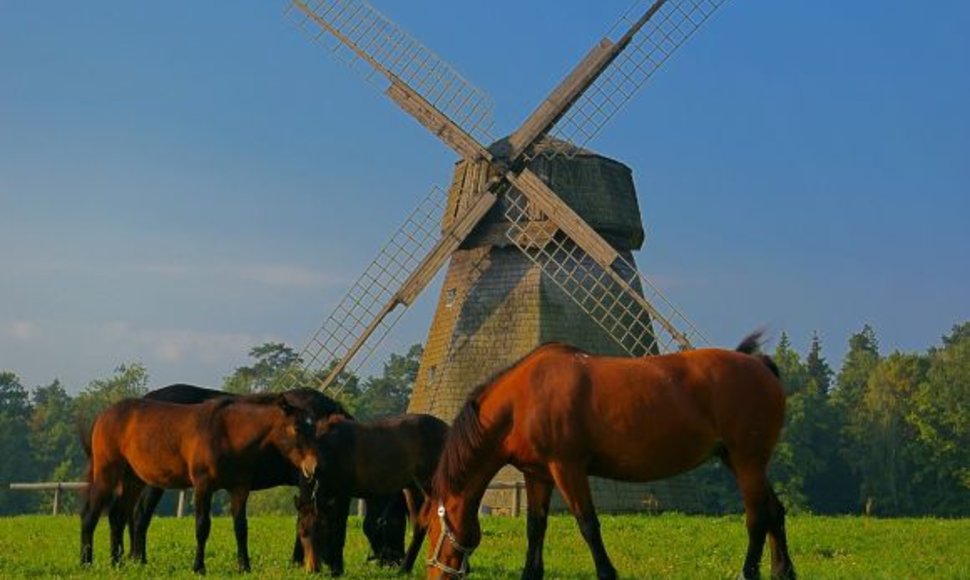Lithuanian hounds, Žemaitukai horses, Šilavotas carp, Lithuanian blueberries – these are national breeds and varieties that have earned renown beyond national borders. Some of them, however, are on the verge of extinction.
According to written sources, 15-century Lithuanian dukes would take hounds on their hunts. In the Middle Ages, every nobleman thought it a matter of pride to have at least a few dogs on his estate.
Before World War Two, hounds were quite plentiful in Lithuania, but the numbers fell sharply after the war and they were crossed with other breeds.
In 1974, when it was decided to bring some order into dog breeding, there were only 78 dogs left that bore some resemblance to the Lithuanian hound – but most of them did not have any pedigree documents.
Cynology enthusiasts like Z.Goštautas, V.Morkūnas, A.Penkauskas have greatly contributed to restoring the breed. V.Klovas worked out standards for the Lithuanian hound breed. Lithuanian cynologists and hunters collaborated to hold the first hound show in 1981, with 62 dogs taking part.
Managing on private funds
Today, there are over 400 pedigreed hounds in Lithuania. Ričardas Barzdenis, president of the Lithuanian Hound Breeders Union, says it is enough to assure the survival of the breed.
“There is a wish to preserve the species, but essentially only a handful of enthusiasts put any work into it. We do not get any EU funding, because hounds were defined as hunting animals, not agricultural. So we have to do on our own pockets,” Barzdenis says.
Hounds are good at following tracks and can quickly detect a hunted animal. When the dog is within 60-80 metres from the animal, it starts barking and drives it towards hunters. However, this ability that has been perfected over centuries is losing its importance in the face of evolving hunting methods.
“Hounds can be very good at spotting blood – it only takes some training. Pity that this ability gets so little publicity. Besides, hounds are strong dogs, they can defend their masters against, say, attacking boars,” Barzdenis says.
He adds that local enthusiasts have been promoting Lithuanian hounds abroad as well. 20 dogs are shipped to Russia and Belarus every year. Over the last few years, three or four Lithuanian hounds have left for the United States.
“A month ago, one hound from Kupiškis was adopted by Latvians,” he rejoices.
International shows are key events in promoting hounds in the world. “Last autumn, we went to Poland. One German expert ordered a puppy after seeing how our hound served and performed blood tracing tasks.”
Foreigners invading the market
In September 2010, ten Lithuanian riders set out on a 2-thousand-kilometre journey from the Old Trakai, in order to repeat a historic feat of medieval Lithuanian dukes – to have their horses drink from the Black Sea. Just like the medieval knights, modern-day travellers rode on Žemaitukai horses.
Žemaitukai are one of the oldest horse breeds in Europe, their first mentions go back to the 6-7th century. They are the gold of Lithuanian gene pool.
In the beginning of 2013, there were 556 pedigreed Žemaitukai in Lithuania. In 1994, when it was decided to revive the breed, there only 42 horses were found in the country.
“Since then, the number of horses grew tenfold. A celebration is in order, it would seem, but we know that the task could have been accomplished much more smoothly,” says Valė Macijauskienė, head of the Žemaitukai Horse Breeders' Association. She says the state should be more supportive of efforts to keep the breed alive and well.
Lithuania has pledged to preserve Žemaitukai. This proves to be an increasingly challenging task as more and more international mediators are entering the market whose aim is to flood Lithuania with foreign-bred horses.
“Resisting commercial interests proves to be difficult – businesspeople are choosing foreign-bred horses. So you grow a good stud, but no one wants to buy it in the country. And it would be a shame to sell it abroad and let go of such good genes. We'd like to see more support, moral and material, for Žemaitukai breeders. The current system works in a way that makes growing foreign breeds more profitable than Lithuanian ones,” Macijauskienė believes.
Lost generation of scientists
Žemaitukas is a universal horse, it is suitable for professional racing, leisure riding, transportation. It is a particularly strong horse as well as highly manoeuvrable, enduring, and fast. Both adults and children can ride Žematikukai.
“Relations with humans are very important for them. When a disabled child is seated on a purebred stallion, the horse changes, it empathizes with the rider. These horses are very affectionate – they are very sensitive to changes of riders or their feeders,” says Macijauskienė, who has greatly contributed to efforts of repopulating Žemaitukai.
Is there still any threat to survival of the breed? There is one, she says: “The problem is that while there are enough horses, too few people know how to properly handle the breed. It is impossible to hire a young specialist to work in a scientific institute, someone to learn from experienced scientists in order to carry on with their work. This is how I was taught, while now I cannot nurture a young person because they keep cutting staff.”
While international companies keep eyeing the Lithuanian market, there are no efforts on Lithuania's part to promote Žemaitukai abroad. “We should participate in international shows, fairs, take them out and present the breed. As things stand now, the national breed is not even properly promoted in the country – people learn about it through word of mouth,” Macijauskienė regrets.
International recognition
If you go to see the blueberry collection at Vytautas Magnus University Botanical Gardens in Kaunas this time of the year, it will not seem as anything special – that is because the plants are in hibernation awaiting spring.
But one day quite soon, the plants will start bearing big palm-sized bunches of blueberries. Lithuanians have managed to breed a strain that is exceptional for its early fructification, high yields, excellent taste, and commendable biochemical composition of berries.
Lithuanian blueberry varieties like Danutė and Freda are products of diligent work by scientists that took over thirteen years to accomplish. But the efforts are now bearing fruit – Lithuanian blueberries have been recognized internationally. They are put down in European as well as Lithuanian lists of garden plant species.
Staff at the botanical gardens are happy that the plant, which came to Europe from North America, has readily adapted to the Lithuanian climate – it bears fruit every year, is resistant to spring frosts, and the quality of berries is exceptional.
“The demand is massive – we can only meet some 5 percent of demand for these berries. People are concerned about health, so their interest in blueberries grows every successive year. First of all, they appear earlier than any other berries. Second, they are of exceptional chemical composition,” says blueberry researcher Dr. Laima Česonienė.
Blueberries are good for one's eyesight, for proper functioning of nerve cells, blood vessels. Moreover, the plants are pleasing to the eye.
“Third, people are endorsing the slogan 'buy Lithuanian product', so they prefer locally-bred and not imported blueberries, despite the fact that, last year, Lithuanian seedlings cost 40 litas (12 euros) apiece, while other varieties were 15-20 litas,” Česonienė says.
However, the botanical garden breeds blueberries for scientific research and only sells surplus in garden fairs. Seedlings it supplies can hardly meet the demand from amateur gardeners, let alone big farms.
“There is some potential. Blueberry is a very valuable plant for commerce, it could be grown in plantations, like black currants. They did a good job in Kaunas – not only did they breed a new variety, but they knew how to present it to the society, promote and explain it,” says Vytautas Ruzgas, head of Agriculture Institute at the Lithuanian Agrarian and Forestry Science Centre.
World-wide competition
When it comes to selective breeding, there are three parameters to be taken into account: competition, agricultural value, and economic return.
Ruzgas notes that selective breeding is mainly directed towards domestic markets. “You breed a new variety which is better adapted to local climate – and that means greater yields. If you grow more production, exports grow,” he explains.
Most countries in the world have their own selection programmes, so Lithuanian selective breeders are competing internationally.
“The greater the economic value of a variety, the more intense the competition. If you want to breed a new kind of flowers, you might just be competing with yourself. But if you're working with rape, wheat, or beetroot, you will have dozens of competitors,” says Ruzgas who has bred 15 new varieties of wheat over his career.
Several years ago, well-known breeding companies from Austria, Belgium, Denmark, Poland, Germany, France, Sweden, and Switzerland asked to enter their creations into the Lithuanian national plant variety list.
According to the State Crop Growing Service, 786 new varieties were added to the list in 2012 alone. Only one fifth were bred by Lithuanians.













